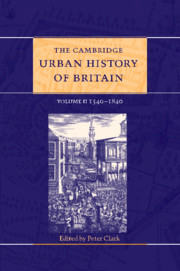Book contents
- Frontmatter
- 1 Introduction
- Part I Area surveys 1540–1840
- Part II Urban themes and types 1540–1700
- 5 Towns in an agrarian economy 1540–1700
- 6 Population and disease, estrangement and belonging 1540–1700
- 7 Politics and government 1540–1700
- 8 Reformation and culture 1540–1700
- 9 The urban landscape 1540–1700
- 10 London 1540–1700
- 11 Great and good towns 1540–1700
- 12 Ports 1540–1700
- 13 Small market towns 1540–1700
- Part III Urban themes and types 1700–1840
- Select Bibliography
- Index
- References
9 - The urban landscape 1540–1700
from Part II - Urban themes and types 1540–1700
Published online by Cambridge University Press: 28 March 2008
- Frontmatter
- 1 Introduction
- Part I Area surveys 1540–1840
- Part II Urban themes and types 1540–1700
- 5 Towns in an agrarian economy 1540–1700
- 6 Population and disease, estrangement and belonging 1540–1700
- 7 Politics and government 1540–1700
- 8 Reformation and culture 1540–1700
- 9 The urban landscape 1540–1700
- 10 London 1540–1700
- 11 Great and good towns 1540–1700
- 12 Ports 1540–1700
- 13 Small market towns 1540–1700
- Part III Urban themes and types 1700–1840
- Select Bibliography
- Index
- References
Summary
THE FOUNDATIONS
the topography of British towns at the beginning of the sixteenth century was the product of the interaction between successive generations of men and women living in society, and the opportunities and constraints presented by their environment over the preceding millennium. Volume I of this work, more especially Chapters 8 and 16, gives an account of the medieval antecedents to this chapter.
Of all the features of towns inherited from the medieval centuries, the street plan, once laid down, has proved to be the most enduring, matched only by the similar longevity of the boundaries of the burgage plots which composed the spaces between the streets. The layout of both could be profoundly affected by the line of any fortifications which might be present. By the end of the medieval period well over a hundred English and Welsh towns had been fortified, including Coventry, Southampton, Hereford and Newcastle-upon-Tyne, ‘the strength and magnificens of the waulling of this towne’, Leland thought, ‘far passith al the waulles of the cities of England and of most of the townes of Europa’. Numerous others, including Aylesbury, Chelmsford and Trowbridge, were not fortified, whilst in some cathedral cities the close formed a separate fortified enceinte, as at Salisbury.
Many town walls were, by the beginning of this period, ruinous, and there was much encroaching and piecemeal destruction. A survey of Oswestry made in 1602 revealed great waste made on the castle, with stones carried away by the wagon load and whole towers taken down, with the gates of the town all very ruinous except Churchgate, where the burgesses had made their election house.
- Type
- Chapter
- Information
- The Cambridge Urban History of Britain , pp. 289 - 314Publisher: Cambridge University PressPrint publication year: 2000
References
- 2
- Cited by

